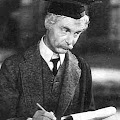
"Newell Convers Wyeth was born on October 22, 1882, in Needham, Massachusetts. Growing up on a farm, he developed a deep love of nature. His mother, the daughter of Swiss immigrants, encouraged his early artistic inclinations in the face of opposition from his father, a descendant of the first Wyeth to arrive in the New World in the mid-17th century. His father encouraged a more practical use of his talents, and young Convers attended Mechanic Arts High School in Boston through May 1899, concentrating on drafting. With his mother's support he transferred to Massachusetts Normal Art School and there instructor Richard Andrew urged him toward illustration.
In 1911, the publishing house of Charles Scribner's Sons engaged Wyeth to illustrate Robert Louis Stevenson's Treasure Island, his first commission in Scribner's popular series of classic stories. The 17 paintings that make up the set are masterpieces of American illustration. Their size and scale, unusual in illustrations of the period, give the paintings a heroic quality that is apparent even in the greatly reduced reproductions. Within the set of illustrations, Wyeth brilliantly mixed subject matter. Action and character study are united in each painting to further the narrative beyond the text. In every canvas, Wyeth's superb sense of color and his ability to mix painterly passages with authentic detail prove him a master of the art. Complex compositions and his skillful use of intense light contrasted with deep shadow contribute to a palpable dramatic tension inherent in the paintings and not dependent on the text. These pictures made the Wyeth-illustrated edition of Treasure Island a favorite of generations of readers.
The success of Treasure Island insured Wyeth a long career with Scribner's, illustrating in succeeding years many classic stories. Among the most famous titles are Kidnapped (1913), The Black Arrow (1916), The Boy's King Arthur (1917), The Mysterious Island (1918), The Last of the Mohicans (1919), The Deerslayer (1925), and The Yearling (1939). He also created illustrations for other publishers, for books such as Robin Hood (Philadelphia: David McKay, 1917); Robinson Crusoe (New York: Cosmopolitan, 1920); Rip Van Winkle (Philadelphia: David McKay, 1921); Men of Concord (Boston: Houghton-Mifflin, 1936); and Trending Into Maine (Boston: Little, Brown, 1938).
Despite his fame as an illustrator, Wyeth yearned to be known as a painter. The distinction between painting and illustration was an important one, with illustration carrying a pejorative connotation that Wyeth felt keenly all his life. Even though the commissioned work earned him income to support his family, he tried to escape the confines of textual limitations with personal paintings that included landscapes, still lifes, and portraits. From lyrical landscapes in an Impressionist style to powerful portraits of fishermen that recall the work of the American Regionalist artists, Wyeth experimented throughout his career with a wide variety of subjects and styles. However, he never did attain the personal satisfaction or public recognition that he sought."
from ncwyeth.org


















Wow! These are beautiful. I love how soft and dream-like everything looks. Gorgeous! :D
ReplyDeleteIndeed - sooo soft and opalescent.
ReplyDelete